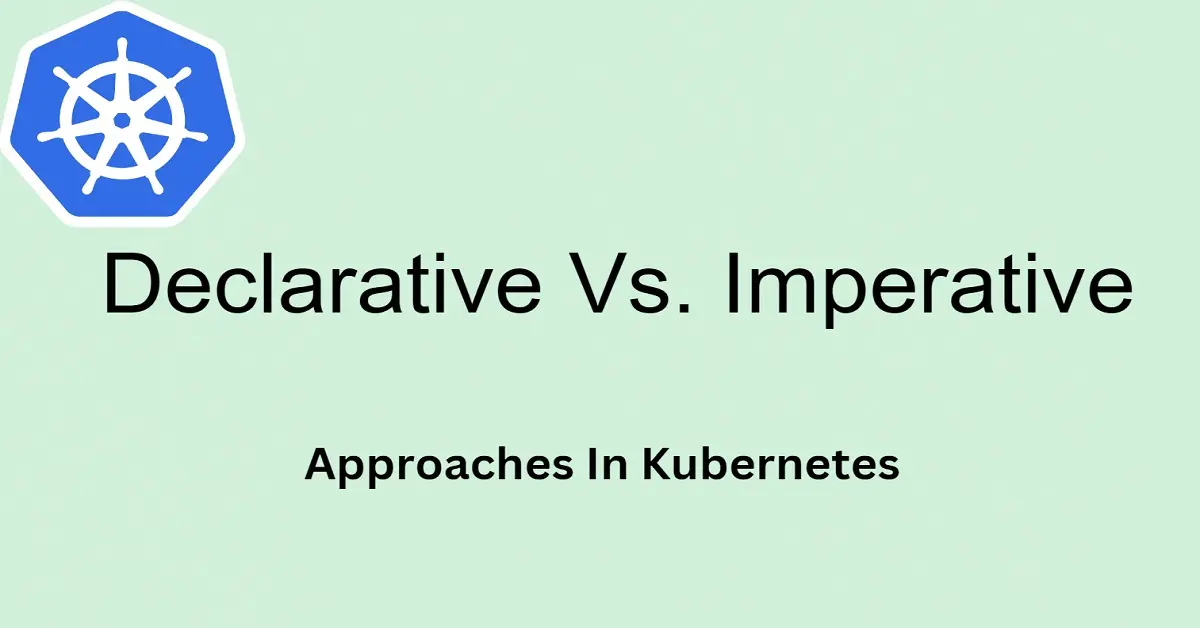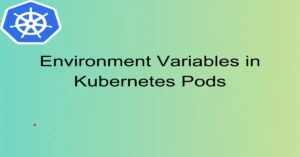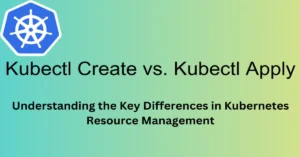Discover the differences between the declarative and imperative approaches in Kubernetes. Learn how to define desired states using YAML or JSON files, or give direct commands to Kubernetes. Explore examples and understand when to use each approach for efficient application and infrastructure management.
Table of Contents
Introduction
Declarative Approach in Kubernetes
Imperative Approach in Kubernetes
Choosing the Right Approach
Combining Declarative and Imperative Approaches
Conclusion
FAQs
Introduction
As the adoption of Kubernetes continues to grow, it becomes crucial for developers and system administrators to understand the different paradigms of interacting with the platform. Kubernetes offers two primary approaches: declarative and imperative. In this blog post, we will delve into the concepts of declarative and imperative methodologies, exploring their differences, use cases, and benefits.
Declarative Approach in Kubernetes
Declarative Kubernetes manifests the desired state of the system without explicitly specifying the steps required to achieve that state. In other words, it focuses on describing the desired outcome rather than the detailed procedure. The declarative approach is heavily based on Kubernetes YAML manifests, which define the resources and configurations of the cluster.
-
Desired State: Declarative Kubernetes emphasizes defining the desired state of the system. This includes specifying the desired number of replicas, image versions, resource requirements, and other relevant parameters.
-
idempotent Operations: Kubernetes continuously monitors the cluster state and reconciles any discrepancies between the desired state and the actual state. It ensures that the desired state is always maintained, making the operations idempotent. If the desired state is already achieved, Kubernetes takes no action, reducing the risk of unintended changes.
-
Version Control and Auditing: Since declarative manifests are stored as YAML files, they can be version controlled using tools like Git. This allows for easy tracking of changes, rollbacks, and auditing of the cluster configuration.
-
Scalability and Automation: Declarative Kubernetes aligns well with scalability and automation. It facilitates managing large-scale deployments by abstracting the complexities of manual operations and allowing for automated provisioning and scaling of resources.
Example – Deployment:
apiVersion: apps/v1 kind: Deployment
metadata:
name: my-app
spec:
replicas: 3
template:
metadata:
labels:
app: my-app
spec:
containers:
- name: my-app-container
image: my-app-image:1.0
kubectl apply -f deployment.yaml
Kubernetes will examine the current state, compare it with the desired state described in the YAML file, and make any necessary changes to ensure the desired state is achieved.
Imperative Approach in Kubernetes
Imperative Kubernetes, on the other hand, focuses on explicit instructions and step-by-step procedures to achieve the desired state of the cluster. It involves using imperative commands, often executed through the Kubernetes command-line interface (kubectl), to manipulate resources directly.
-
Procedural Operations: Imperative Kubernetes provides a more granular level of control by specifying each step required to reach the desired state. It involves creating, updating, or deleting resources one by one, giving developers more flexibility.
-
Interactive Development and Debugging: Imperative commands are useful during development and debugging phases, allowing developers to make quick changes, experiment, and observe immediate results.
-
Operational Flexibility: Imperative commands enable operations that might not be possible with declarative methods alone. This flexibility comes in handy in scenarios where fine-grained control is required, such as debugging, troubleshooting, or handling one-time tasks.
Example – Pod Creation:
kubectl run my-pod --image=my-image:1.0 --replicas=3
Choosing the Right Approach
When deciding between declarative and imperative Kubernetes, several factors come into play:
-
Complexity of Operations: If the operations are straightforward and can be effectively expressed in a declarative manner, it is advisable to leverage the simplicity and automation of declarative Kubernetes. However, complex operations or one-off tasks may benefit from the explicit control provided by imperative commands.
-
Collaboration and Auditing: Declarative manifests, being version controlled, facilitate collaboration among team members. They provide a clear history of changes and allow for auditing and reproducibility. Imperative commands, while useful during development, might lead to undocumented and untraceable changes.
-
System Scalability: Declarative Kubernetes is more suitable for managing large-scale deployments and automating resource provisioning. It provides a scalable and consistent approach to managing clusters.
Combining Declarative and Imperative Approaches
Example – Scaling:
kubectl scale deployment my-app --replicas=5
Conclusion
Both declarative and imperative approaches have their merits in Kubernetes, and understanding when to use each is essential. Declarative Kubernetes offers simplicity, scalability, and automation, allowing developers to define the desired state and leave the rest to Kubernetes. Imperative Kubernetes, on the other hand, provides fine-grained control, interactive development, and flexibility for complex operations and debugging scenarios.
By considering the nature of the task at hand, the collaboration requirements, and the desired level of control, developers and system administrators can make informed decisions about which approach to use. Ultimately, a hybrid approach that combines the strengths of both paradigms may be the most effective solution for managing Kubernetes clusters efficiently.
FAQs
1. What is the declarative approach in Kubernetes?
The declarative approach in Kubernetes involves describing the desired state of your application or infrastructure using YAML or JSON files. You specify the desired configuration and let Kubernetes handle the execution and maintenance of the system to match that desired state.
2. What is the imperative approach in Kubernetes?
The imperative approach in Kubernetes involves giving specific commands to Kubernetes to perform certain actions. With the imperative approach, you directly instruct Kubernetes on what to create, modify, or delete, without explicitly defining the desired end state.
3. Which approach is recommended for managing applications in Kubernetes?
The declarative approach is generally recommended for managing applications in Kubernetes. It provides a more robust and scalable way to define and maintain your desired state. By defining the desired configuration, Kubernetes can continuously work towards achieving and maintaining that state.
4. What are the advantages of the declarative approach?
The declarative approach offers several advantages:
It enables idempotency, meaning you can repeatedly apply the same configuration without causing conflicts or inconsistencies.
It allows for easy collaboration and version control since configuration files can be stored in source control systems.
It simplifies troubleshooting and recovery since the desired state is explicitly defined, making it easier to identify and rectify any discrepancies.
5. When would the imperative approach be useful?
The imperative approach can be useful in certain scenarios, such as quick ad-hoc operations or debugging tasks. It provides more direct control and immediate feedback, allowing you to make changes on the fly without defining a desired state.
6. Which approach is more prone to errors?
The imperative approach is generally more prone to errors because it relies on direct commands and manual configuration. Mistakes made during the command execution can lead to unintended changes or inconsistencies. In contrast, the declarative approach is less error-prone as it relies on a defined, version-controlled configuration.
7. Can declarative and imperative approaches be used together in Kubernetes?
Yes, declarative and imperative approaches can be used together. While the declarative approach is recommended for managing your overall system state, the imperative approach can be useful for ad-hoc tasks or fine-grained control when needed.
8. Are there any tools or Kubernetes features that support the declarative approach?
Yes, Kubernetes itself is designed to support the declarative approach. Tools like Kubernetes YAML files, Helm charts, and Kubernetes Operators allow you to define the desired state of your applications and infrastructure in a declarative manner.
9. Are there any tools or Kubernetes features that support the imperative approach?
Kubernetes provides a command-line interface (CLI) called kubectl, which allows you to interact with Kubernetes using imperative commands. It lets you create, modify, and delete Kubernetes resources directly through command-line instructions.
10. Which approach is more suitable for managing complex, scalable systems?
The declarative approach is more suitable for managing complex, scalable systems. It enables you to define the desired state of your system and leverage Kubernetes’ ability to continuously monitor and reconcile the actual state with the desired state. This automation and self-healing capability make it easier to manage large-scale deployments.





Pingback: Kubernetes Pods: A Comprehensive Guide For Beginners - Bitsify